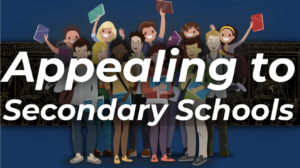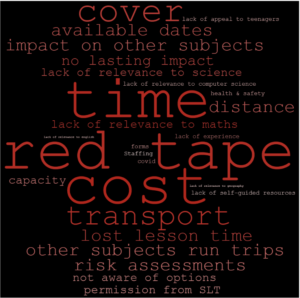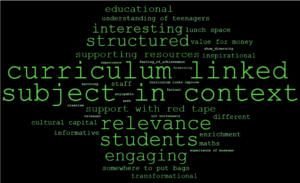Appealing to Secondary Schools
The theme of this year’s GEM Conference was A Way Forward for Museum Learning, which in a single phrase states exactly what we’re all looking for following the lockdowns and other upheavals of recent years whilst also encompassing a plethora of potential themes. Conference conversations revealed an enormous breadth and depth to what moving forwards means, with just one aspect being expanding audiences. Part of that, for many museums, includes enticing more secondary schools to take advantage of their education offer.

This topic is very close to my heart: I am a secondary school teacher and until late 2020 I worked for a heritage attraction with an educational offer that I’m not too modest to state I played a part in developing into a multi-faceted, award-winning and popular learning programme which catered for more secondary than primary school visits (around 65% of on-site visits, and a slightly higher percentage for the outreach programme).
This seems to be an unusual situation in the museum world, with most people estimating a split in the opposite direction: ballpark figures solicited from conference attendees suggested that around 80% of school visits to museums are undertaken by primary schools, but official research is hard to find. The general consensus, though, is that the sector struggles to attract secondary schools.
Some suggest that this is because secondary schools simply do not want to, or cannot – for various reasons – visit museums (with the corollary that it’s not worth trying). As a secondary school teacher I can state categorically that this isn’t true: this year at school I’ve been involved in finding a host of visits to book for our students with the intention of embedding two annual trips into each year group’s calendar. It’s not just us: collecting data for a recent research project towards my MA in Education included interviewing a handful of mathematics teachers who have also taken Key Stage 3 students to museums.
Now I’ve mentioned the M-word I’ll stick with it for a while: one of the reasons that secondary nay-sayers provide for schools’ lack of interest is that taking students out of multiple subjects’ lessons for a day is too difficult. There’s a germ of truth in this: a day out for secondary school students needs to be justified according to different criteria than for primary school students, and this is one of them: It’s almost certain that students will miss lessons for subjects other than the one organising the visit, so buy-in from these subject heads and senior leadership is crucial, but not impossible, and easier for a cross-curricular trip. There’s a high probability that at least one missed lesson will be mathematics – a core subject – so if the trip has an explicit mathematical link then all the better.
“But my museum doesn’t have any mathematical links!” is regularly cried at this point. My only honest response to this is that I, an avid museum-goer, am yet to visit one where mathematics isn’t dripping from every object; running through every seam; visible in every crack; and audibly humming in the brickwork. The problem isn’t that it’s not there; it’s that British society puts so much effort into pretending that mathematics is pointless, boring, esoteric nonsense with no real-world relevance that we learn to ignore its signs from an early age.

Barriers to organising museum trips as reported by 36 secondary school teachers:
I digress. My research project focused specifically on mathematics teachers who have taken students on school trips. If you’d like to read it please get in touch, but a key finding was that there are definitely secondary maths teachers who want to take students on trips, and some of these are actually facing pressure from above to make it happen. Barriers identified included not being able to find relevant trips, and the costs involved. Some solve the first problem by utilising teacher pre-visits to develop their own materials to support students finding and exploring mathematical links that the museums hadn’t highlighted. Regarding costs, the largest part of this was often that of transporting students to the museum: teachers may consider a visit to a more local museum over and above a more distant one if something relevant to their students is available.
Another worry that many of the museum educators I’ve spoken to have regarding developing secondary school content is the belief that teachers want everything to be “curriculum linked.” All teachers in my project stated this as a necessity, and it’s often interpreted by museum educators to mean that students must leave having been taught (or revised) some part of that subject’s curriculum; i.e. they depart being that bit better prepared for something that may come up in an exam. Whilst this may well be something that teachers would mark as a positive outcome from a trip, it’s not necessarily what they mean when they say “curriculum linked.” In my project, for example, explicit curriculum topic links were stated as necessary for two key reasons: getting the OK from SLT; and for assurance that work had been done to target the material appropriately. Much more important to the interviewees were opportunities for students to experience mathematics in context and to leave the site feeling a bit more positive about maths than they did when they arrived.

The most important considerations when organising a school trip, as reported by 36 secondary school teachers.
When Alison from GEM East approached me to provide some training on the subject of making museum learning programmes more appealing to secondary schools I thought I’d better find out how my research findings relate to secondary teachers beyond maths, so I solicited responses to two surveys: one for museum educators; one for secondary school teachers. These were far less rigorous than my MA project but they do seem to suggest that the findings I’ve outlined above may well be applicable more broadly, though the potential for differences between subjects does exist: the fact that some subject teachers (History & English, maybe) sometimes have more experience of leading school trips than others is one example. I’ve included two word clouds constructed from the teacher survey responses: one shows key words relating to teachers’ stated barriers to undertaking visits; the other presents things they said were the most important considerations.
With all this in mind, I’ll finish with what I’m confident constitutes appropriate advice for any museum wanting to start work on expanding their learning programme to appeal to secondary schools:
- Secondary schools want to provide their students with experiences like museum visits.
- Cross-curricular experiences are valuable: museum visits provide opportunities to break down teaching silos for a day.
- “Curriculum links” has a broader meaning than you may be assuming.
- The cost of transport is often the limiting factor: you potentially have a competitive edge amongst local schools over bigger, better known but more distant offers.
Final, final point: There are a lot of assumptions amongst museum educators about what secondary schools want, but for every truth shared there’s also a misconception; and what attracts one museum’s local secondary schools may not have the same effect elsewhere. The only way to make sure you’re developing something that’ll work for your local schools is to develop it with them: truly collaborative relationships are key. How to form these relationships is another question: if you’ve managed it, maybe you’d like to describe your experiences in the comments.

Tom Briggs
Tom is a secondary school mathematics teacher for 40% of his working week and a freelance museum learning consultant for the other ⅗. He tweets as @TeaKayB and toots as @[email protected]. For a portfolio of work, contact details and other information, head to tkbriggs.co.uk.
